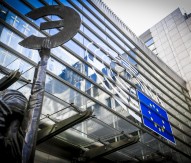
Analysis… Stop the invaders
Europe is now halfway towards the main EU target of ‘halting the loss of biodiversity and the degradation of ecosystem services’ by 2020. However, this remains a serious challenge, with the European Environment Agency indicating in its 2015 report on the state and outlook of the environment that the EU is unlikely to meet its main 2020 biodiversity targets.
Recent data shows that 60% of species assessments and 77% of habitat assessments continue to be in unfavourable conservation status. Constant habitat loss, diffuse pollution, the overexploitation of resources, and the growing impact of climate change contribute cumulatively. After the habitat loss, invasive alien species (IAS) are the second most significant threat to biodiversity and the major cause of species extinctions. Some invasive species can cause health problems, for example asthma or allergies, whilst others damage infrastructure, reduce the value of land and water, hamper forestry or lead to agricultural losses.
IAS are estimated to cost the Union at least €12bn annually, with damage costs continuing to increase. In 2014, the European Parliament and the Council of the European Union passed an ambitious legislative framework on regulating IAS in the EU. If implemented and executed in practice, this legislation could be a crucial step to fulfil one of the six targets covered by the EU 2020 Biodiversity Strategy. The Commission’s 2013 legislative proposal for a ‘regulation on the prevention and management of the introduction and spread of IAS’ established a good framework for action to tackle IAS in the Union, but there are still several aspects that need to be further developed.

Pavel Poc MEP
Biodiversity Strategy
The targets of the EU Biodiversity Strategy to 2020 address the main drivers of biodiversity loss. The Commission sees the strategy as reducing the main pressures on Nature and ecosystem services in the EU by anchoring biodiversity objectives in key sectoral policies. By the end of the decade, the Union is expected to meet six targets, namely ‘fully implement the Birds and Habitats Directives’, ‘maintain and restore ecosystems and their services’, and ‘increase the contribution of agriculture and forestry to biodiversity’.
The final three objectives are ‘ensure the sustainable use of fisheries resources’, ‘combat IAS’, and ‘step-up action to tackle the global biodiversity crisis’. The Commission cites the importance of financial resources, engaging with key stakeholders, and co-ordination at regional, national and supranational levels to implement the strategy.
Committee views
After profound work, the Parliament’s Environment, Public Health and Food Safety (ENVI) Committee adopted its position in January 2014 on the proposed ‘regulation on the prevention and management of the introduction and spread of IAS’. The committee decided on and provided a negotiating mandate to begin talks with the Greek Council Presidency and the European Commission to ensure negotiations could be completed before the end of the legislative term.
Key amendments adopted by the ENVI Committee aimed not only to remove the proposed cap of 50 IAS to be put on a Union list of concern, but also other, more important measures. Changes proposed include: how to tackle the inclusion of IAS that are native to a part of the Union but invasive to another on the Union list; how to approach IAS incapable of forming viable populations in some regions if EU member states should be allowed to set priorities in line with the conditions in their territory; how to address animal welfare concerns; and permits for breeding species of high social and economic value.
The committee also agreed that the information support system should be improved, that the public should have the opportunity to voice their opinion, and that a dedicated scientific forum supporting the decision making process should be set up as a priority.
Tough negotiations
In the first trialogue, the Parliament, Council and Commission held an extensive exchange of views on their respective positions, which initially were quite far apart. Key divisions include the composition of the list of IAS of Union concern, national derogations, permits and authorisations, risk assessment, and ways to involve the scientific community in the implementation of the new regulation.
Despite the pessimistic view during the second trialogue, negotiators were able to agree on an overall compromise package that was endorsed in ENVI as well as by all political groups. The compromise found sees the potential to strengthen the European dimension in tackling the IAS challenge while providing sufficient flexibility to EU member states to address issues specific to their territories.
Key achievements
The new measures were agreed to prevent new IAS from entering the EU and to deal more effectively with the ones that are already established here. A list of IAS of Union concern will be drawn up with EU member states using risk assessments and scientific evidence. At the same time, the proposal allows member states to set priorities in line with the conditions in their territory.
Efforts to minimise the impact of IAS will be coherent in EU countries, covering the entire Union, and will be better co-ordinated, meaning that their overall effectiveness will be improved. An early warning and rapid response system will help member states to cut the damage costs and further prevent the negative impacts related to the new invasions.
Composition of the list of IAS of Union concern will be established based on common criteria and reviewed every six years. Species that are not able to establish a viable population in a large part of the EU can be included in the list if measures at Union level are more appropriate to achieve the objectives of the regulation.
IAS of regional concern and species native to the EU will be addressed by way of enhanced regional co-operation between concerned member states, facilitated by the Commission. The effectiveness of the provisions on species of regional concern and the need for and feasibility of including native species in the list of species of Union concern will be assessed on the basis of a review clause. In exceptional cases of compelling public interest and subject to authorisation by the Commission, member states may grant permits for certain activities involving IAS.
Member states may also maintain or lay down more stringent national rules with the aim of preventing the introduction, establishment and spread of IAS. A scientific forum will be established comprising representatives of the scientific community appointed by the EU countries.
R&I support
The Commission is supporting action on IAS through its existing financing instruments, with Horizon 2020 possibly addressing them. A milestone EU research project on IAS was ‘Delivering Alien Invasive Species Inventories for Europe’ (DAISIE), which brought together data about biological invasions across Europe and was supported by the EU’s Sixth Research Framework Programme.
It would be a good target for Horizon 2020 financing to support scientific work helping to broaden knowledge of IAS ecology, or to address issues of their spreading or specificity of their eradication in the most sensitive parts of Nature, protected natural areas, protected water resource areas, etc.
If I might have one wish for the research in this field, it would be the research of the pathways of spreading of IAS. It is, of course, the obligation of the EU member states to analyse the pathways according to the new directive, but without strong scientific support, it will end as an administrative exercise without any true achievements.
Regulation 1143/2014 on the prevention and management of the introduction and spread of IAS was published in the Official Journal of the European Union in November 2014 and entered into force on 1 January 2015. Working with IAS for more than 20 years and witnessing the day of adoption of this regulation was of a great satisfaction; what we have been missing during recent years was the necessary legislative framework for our efforts.
Only with the appropriate legislative tool can all efforts to minimise the impact of IAS be coherent in EU member states. Only coherent efforts can repress substantially established invaders, further preventing the negative impact relating to new infiltrations and contributing to halting biodiversity loss.
Pavel Poc MEP
This article first appeared in the seventh edition of Horizon 2020 Projects: Portal, which is now available here.




